













A Simplon Bilateral slide rule made by Dargue Bros of Halifax (1934 patent). It dates from the mid-twentieth century. This model was introduced in 1935 when it sold for 7/6. It is a ten inch duplex (double sided) rule made of plastic faced mahogany. Unusually, there are two cursor grooves along each edge of the rule and the cursor has to be removed and put on the other side to use the scales on the reverse. Scales are: LU,A{B,C1,C}D,LL//A,S,L,T,D. Maroon card case.

A Simplon Primary Log Log ten inch slide rule. This is the Simplex equivalent of the Bilateral with the following scales: LU,A{B,C1,C}D,LL. Blue card case and instruction leaflet.

John Davis & Son (Derby) Ltd mahogany and celluloid, ten inch, closed frame slide rule. Scales are: F,A{B,C}D,E//{S,T}. There are inch & metric rulers on the edges and tables on the reverse. The rule has DRP No 126499 in the well. This was a Dennert & Pape patent suggesting that they made this rule for John Davis who’s name only appears on the maroon cloth covered card case.

Reliance Rule Slide 10” (made for UK government - broad arrow mark). Mahogany & celluloid, closed frame, the inch & metric rulers on the edges are reinforced with metal mesh. Scales are: A{B,C}D//{S,L,T}. Cursor apertures and tables on the reverse. Brown, cloth covered, card case.
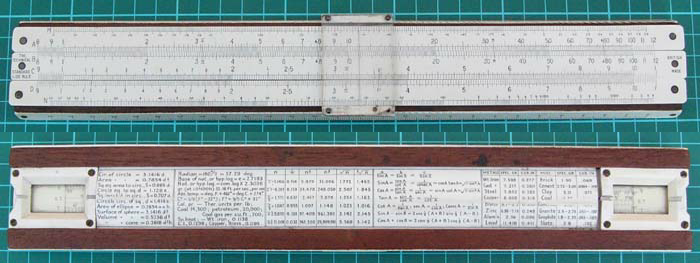
The Technical Standard Slide Rule. Closed frame, ten inch mahogany & celluloid with unusual cursor windows on the reverse, plus tables. Scales are: M,A{B,C}D,N//{S,ST,T}. (M & N are usually denoted LU & LL or LL2 & LL3). Made by the British Slide Rule Co, a subsidiary of Marine & Overseas.

An Otis King model K cylindrical slide rule (no. T1568) dating from the 1950s. These rules were made by Carbic Ltd. It is made of chrome plated brass with paper scales. Because of the spiral nature of the scales they were very long (66 inches) and hence calculations would be more accurate. It is complete with instructions and box. Scales are nos. 414 and 423.
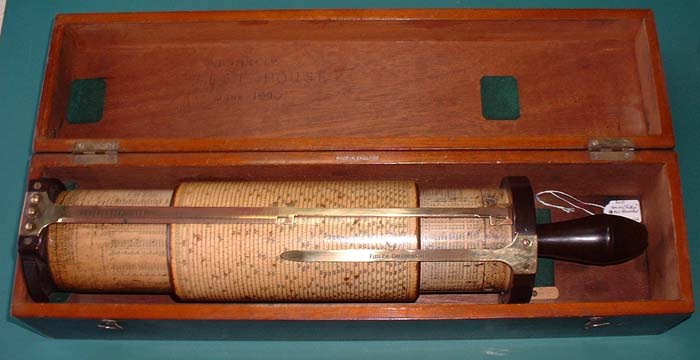
A Professor Fuller's No. 1 Calculator made by W F Stanley in its fitted, mahogany box. The stand is missing. The box has the date 1940 in the lid but the rule serial no. 9957 50 shows that the rule was made in 1950 and has changed boxes with another at some time These rules were accurate to five significant figures as a result of the extremely long (500 inch) spiral scales. It is complete with its instruction booklet. They were first manufactured in 1878 and changed little throughout their long period of manufacture except for the replacement of wood by Bakelite for the handle and ends. They continued to be manufactured until 1975.
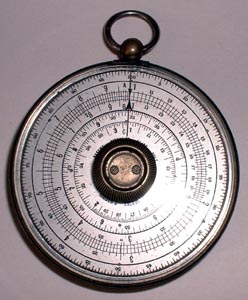
Halden's Calculex. This one dates from circa 1925. It is double sided and the inner disc is rotated by the thumb nut in the centre. The cursors are marked on the glass faces which can also be rotated. It is complete with leather wallet and a copy of "revised Rules, Tables and Formulae for Patent Circular Slide Rule (Halden Calculex)" - a 2 1/4" square, 96 page booklet which is also housed in a pocket in the case and which cost an extra 1/6. On one side there are A, B,& C scales, whilst on the other are A with B reversed. There are a variety of other scales on each side as well.
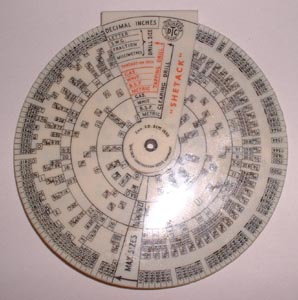
A "Shetack" calculator for tapping and clearance drill sizes for different threads, made by DTC. It is a second edition September 1938 model. It is made of celluloid. These were later advertised by Fowler (Ref: Fowler’s Mechanical Engineer’s Pocket Book 1947)

Classic Series V 10” closed frame slide rule made from mahogany with celluloid covered paper scales and a metal/celluloid cursor. Scales are: in\LL2,A{B,S,T,C}D,LL3\cm. There are tables on the back. It has a card box (rather battered). It probably dates from the 1940s.

Classic Series II closed frame slide rule made from mahogany with celluloid covered paper scales and a metal/celluloid cursor. Scales are: in\LL2,A{B,C}D,LL3,\cm. It has tables on the reverse which are different to those on the Series V above.


Classic Series I mahogany slide rule with celluloid covered paper scales and a metal/celluloid cursor. This 10” slide rule has the following scales: in\A{B,C}D\cm. Tables on the back are the same as on the Series II. It has a brown card case.
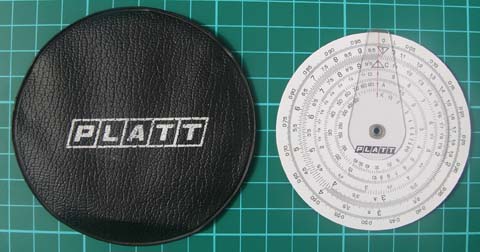
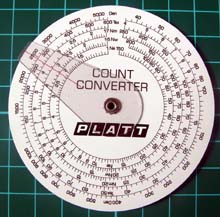
Platt Count Converter and circular slide rule. The upper side is a conventional circular slide rule with scales as follows: L,D{C,C1,A,K}. The reverse has scales for five different types of cloth count to enable conversion between them. Diameter 3”. It has an instruction booklet (printed in Dorchester) and a PVC slip case. The actual manufacturer is not stated. Platt was an Accrington (Lancashire) firm which is a long way from where the instructions were printed. Was the maker a Dorset one (Abbott Brown or Blundell perhaps)?

Helix A 50LL slide rule. A 5” plastic slide rule with clear/blue vinyl slip case. Scales are: cm\LL2,A{B,C}D,LL3. It was probably made in Japan as it is stamped ‘Foreign’ on the back.

Helix Top Precision A 50S plastic 5” closed frame slide rule, complete with instructions and clear/blue vinyl case. Its scales are: K,S,A{B,C1,C}D,T,L. It was probably made in Japan as it is stamped ‘Foreign’ on the back. The printing really is unusually black.


An unusual spring design slide rule made from plywood, with paper scales, 12 inches long overall. It has four slides, two each side. The scales on the upper face are: load in lbs total; fibre stress lbs/sq in; SWG (standard wire gauge); mean dia of coil in ins. On the reverse they are: rate in lbs; no of coils; SWG; mean dia of coil in ins.


TS Emblem Series 1053 Olympic LL plastic 10” slide rule with reversible slide. It has a green and white blow moulded plastic case. The scales are: L,K,A{B,C1,C}D,S,ST,T//cm{S,LL1,LL2}in. It is a clone of the Aristo Scholar 0903LL apart from the branding and highlight colour. It was sold by Technical Sales who had previously been Aristo agents. Made by UCHIDA CO LTD in Japan, probably in the 1960s/70s.

W F Stanley 5” mahogany and celluloid slide rule, made in England, probably in the 1920s. Scales are: in\A{B,C}D\cm//{S,L,T}. It has a brown cloth covered card case. It was probably made for Stanley by A G Thornton
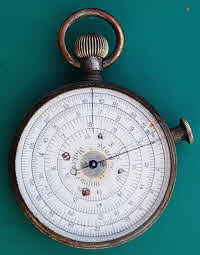

Bouchers Calculator, Stanley Maker London. The top winder rotates the dial on the face marked Stanley. The small winder on the side rotates the hands on both faces together. The Calculigraphe made by Henri Chatelaine in Paris was also a development of Bouchers calculator but operated differently.
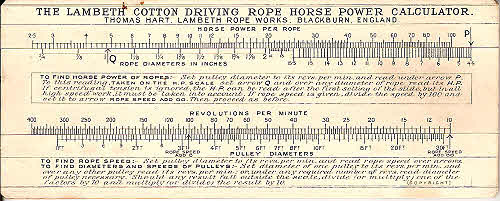
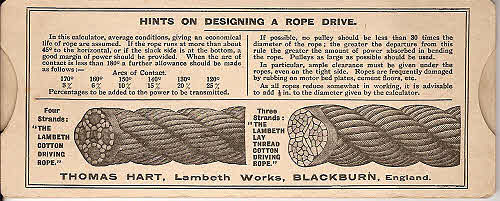
The Lambeth Cotton Driving Rope Horse Power Calculator was given away by Thomas Hart, Lambeth Rope Works, Blackburn England. It is card, 6.3 inches long, with a single slide. Probably early 20th century, it has a paper sleeve.
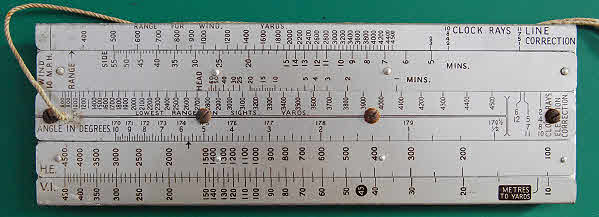

Slide rule for use with the Vickers .303 machine gun dating from 1941. It is constructed from sheet aluminium on what appears to be a Bakelite core. Length 9 inches.


A Simplon Bilateral SB5 slide rule made by Dargue Bros of Halifax (1934 patent). It dates from the 1930s. It is a five inch duplex (double sided) rule made of plastic faced mahogany. Unusually, there is a very wide cursor groove along each edge of the rule and the cursor has to be removed and put on the other side to use the scales on the reverse. Scales are: A{B,C}D//A,S,L,T,D. Maroon card case. A ten inch log-log version can be seen at the top of the page.


A Simplon Primary SP5 slide rule made by Dargue Bros of Halifax (1934 patent). It dates from the 1930s. It is a five inch simplex rule made of plastic faced mahogany. The scales are the most basic set of: A{B,C}D.
There are tables on the reverse. Blue card case. A ten inch log-log version can be seen at the top of the page.


Simplon Duplex 10” slide rule made by Dargue Bros ca.1946. This has two cursor grooves along the edges so the cursor can be reversed as shown in the second picture. The scales are: A{B,C}D//A,S,L,T,D. Unlike the 10” Bilateral it has no log log scales. It has a black card case and instructions, both of which are in poor condition.


C & H Pipe Sizing Slide Rule. The scales are Temperature Drop (pump and gravity){Friction & Operating Head, BTU}Pipe size. Celluloid faced wood made for Clementson & Haywood of London. It has the same scales as the one made by Thornton (see Thornton slide rules page).
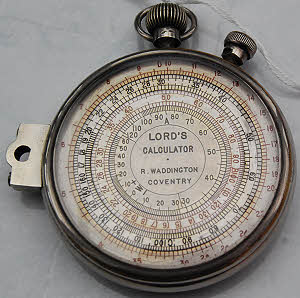
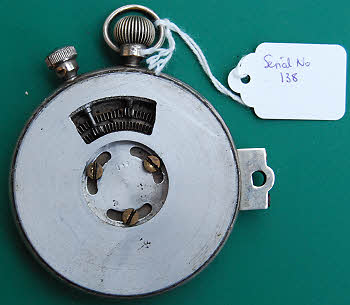
Lords Calculator signed R Waddington Coventry, early 20th century, serial number 138. Stationary inner scale, labelled ‘A’ has clockwise and anti-clockwise scales. Inner rotating scale, labelled ‘B’ is a single radius logarithmic scale rotated by the large crown. Outer rotating scale, labelled ‘C’, rotated by smaller crown and outer fixed scale, labelled ‘D’ are also single radius logarithmic scales. In the second picture the snap on case back has been removed to show the mechanism.


Slide rule made by Dennert & Pape, Altona, Germany for calculating the perforability of wrought iron and armour plate given the diameter, weight and velocity of a projectile. It was one of a pair, the other being in metric units, for comparing British and Continental plate. It is celluloid faced mahogany and is missing its cursor.


Kent’s hydraulic slide rule for calculating hydraulic gradient from the flow, pipe diameter, and velocity for water. Cardboard, approximately 10” LOA with a brown cloth covered card case. The instructions for its use are on the reverse. George Kent & Co were makers of water flow meters for waterworks and also made planimeters, an example of which can be seen on my planimeters page.


TS Emblem Series 1052 plastic 10” slide rule, a Rietz variant with trig scales on lower stock. It has a green and white blow moulded plastic case. The scales are: L,K,A{B,C1,C}D,S,ST,T//cm,in. It is a clone of the Aristo Scholar 0903 apart from the branding and highlight colour. It was sold by Technical Sales who had previously been Aristo agents. Made by UCHIDA CO LTD in the 1960s/70s

Technical Sales Emblem Series No 1051 “Tutor” plastic 10” slide rule. It has a green and white blow moulded plastic case. The scales are: K,CF{DF,C1F,C1,C}D,A. Made by UCHIDA CO LTD in Japan.



Simplon Electro Log Log 10” mahogany/celluloid electrical slide rule. Scales are: LU,A{B,R,C}D,LL//{A,S,T,D}L,D//motor-dynamo,volt in well.

Simplon WR1A ten inch mahogany/celluloid closed frame slide rule. The basic scales are A{B,C}D. The model number is on the plain white celluloid faced back. It has a black card case and instruction booklet.


Dargue Bros. Simplon SR-10 Rietz closed frame duplex slide rule with reversible cursor made of mahogany & celluloid, The scales are: K,A{B,C}D,L//A,S,L,T,D. It has a red cloth covered card case with a retailer’s label and two instruction leaflets.


Dargue Bros, Simplon Major 10” closed frame mahogany/celluloid slide rule with a celluloid cursor. It has a purple paper covered card case. The scales are LU,A{B,C1,C}D//{A,S,T,D}L,D. The slide is not reversible and the scales on its reverse are used in conjunction with the chamfered indicator that can be seen on the left end of the underside of the stock. As with many Simplon rules the scales are quite unconventional.


J Halden & Co “Davis-Scurfield Split Unit” slide rule. 10” steel backed mahogany & celluloid construction, it has brown card case. G Scurfield patent 227643 of 1925; this rule was a presented to Thomas Ivor Jones in 1926. Scales are: cm\S,A{B,T,C}D,L,SU\in. The split unit (SU) scale was for use in non-decimal (e.g.Sterling currency) calculations and similar, the 20 major divisions being suitable for shillings, these being further divided for pennies and half-pennies. The slide rule is described in some detail in the mid-1920s Halden catalogue, page 116. It was made by John Davis & Son (Derby) Ltd who adopted Scurfield’s patent.


Early Stanley ten inch slide rule boxwood stator base, mahogany stator upper and slide faced with celluloid, brass framed cursor. Scales are cm\A{B,C}D\in//{S,L,T}. Possibly made in Germany for Stanley. Unusual construction is a copy of that used by Keuffel & Esser, for whom Stanley were agents in Britain.
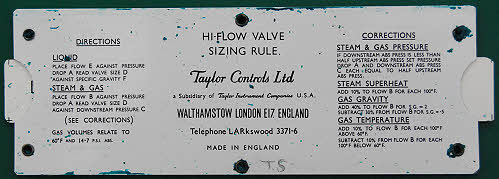
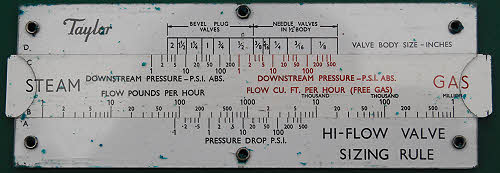
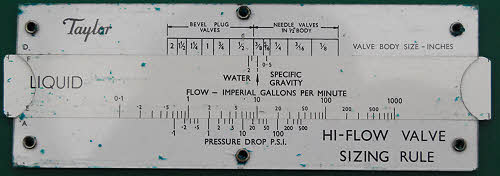
Taylor Controls Ltd HiFlow Valve Sizing Rule. It is made of riveted layers of plastic, the upper one being transparent. Maker unknown but Made in England. The back has the instructions and the slide is reversible to cater for liquids, steam and gases. It has a PVC slip case. Probably dates from the 1950s.
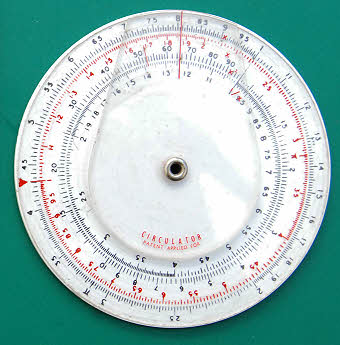
Circulator 3” diameter circular slide rule, maker unknown. Scales are x, x, x2, 1/x. It has a thick white plastic disc, a rotating transparent disc and a rotating plastic cursor. It is complete with red PVC sleeve and instruction leaflet. Ca.1960?
The picture below shows another that is promotional for Lancashire Dynamo Electronic Products Ltd. It too has its case and instructions.





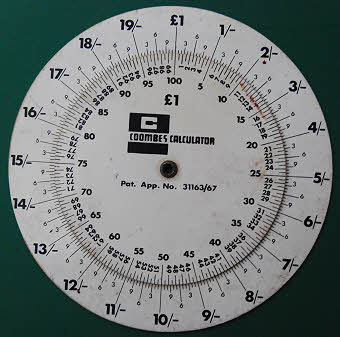
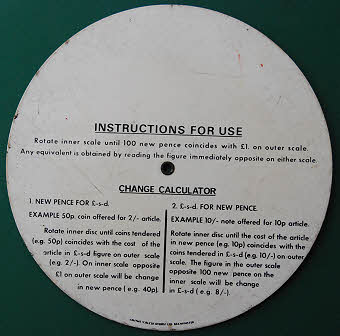
Coombes Chnage Calculator made by Smith’s Calculators, Beaminster, Dorset. 4” diameter plastic calculator. Patent application no. 3163/67. In 1968 the first decimal coins in the UK appeared in circulation, the nickel-silver 5p and 10p (p = new pence). These were the same weight and size as the one and two shilling pieces and interchangeable with them. A new 50p coin was also introduced to replace the ten shilling note. Until 1971 when the remaining ‘new pence’ coins were issued, there were both £sd and decimal coins in circulation and goods might also be priced in either. The purpose of this simple calculator was to calculate the change due when the price was in one system and the amount tendered in the other.
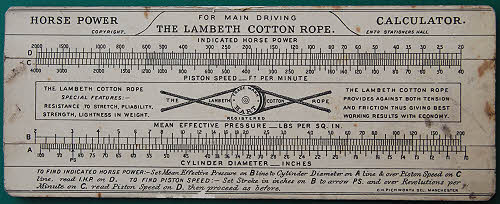
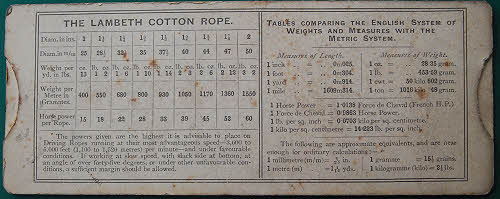
The Lambeth Cotton Rope Horse Power Calculator for main driving. This 6.3” LOA cardboard slide rule was used to calculate the indicated HP of the driving steam engine given its cylinder dimensions, mean effective pressure and speed. The table on the reverse gives the weight of different diameters of rope and the horse power they could transmit. There is also a table of metric size and weight equivalents. Probably early 20th century. Thomas Hart was the firm that made Lambeth ropes.
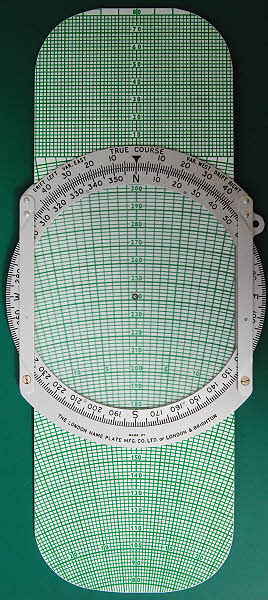
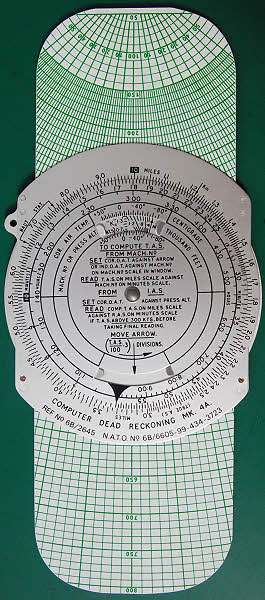
Computer Dead Reckoning Mk 4A Ref No 68/2645 NATO No 68/6605-99-434-3723 made by the London Nameplate Mfg Co Ltd. The circular calculator on the front face is for finding True Air Speed from either Mach No or Indicated Air Speed. The rear face, used with the slide, is for determining the course variation due to the wind. This would have been made for the RAF. I also have the Computer Dead Reckoning Mk 4B (minus slide) that was intended for slower aircraft.
This computer has a vinyl slip case marked with a large broad arrow.


Classic Series IV 10” mahogany and celluloid/paper slide rule. It has a card case. The scales are: in/S,A{B,C1,C}D,T/cm. More Classic slide rules can be seen earlier in this page.


Short & Mason psychometric slide rule for calculating relative humidity. It has a reversible slide, one side for sling/Assman calculations and the other for Stevenson’s Screen. It has an instruction leaflet and a brown PVC slip case.


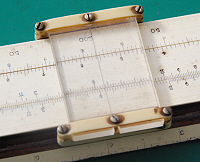
Stanley 20 inch mahogany and celluloid slide rule and its mahogany box. The five
screws in the back are for adjusting the pressure on the slide and are a copy of
the system used by Keuffel & Esser, for whom Stanley were British agents. The scales
are in\A{B,C}D,L\cm//{S,T}. The cursor is unusual and is rather loose so may be a
replacement. It is marked “British Made”.


Classic Series III five inch mahogany slide rule with celluloid covered paper scales and a metal/celluloid cursor. Scales are in\A{B,C}D\cm. Tables on the back are for timber. It has a grey card case.


Classic Series I mahogany slide rule with celluloid covered paper scales and a metal/celluloid cursor. This 5” slide rule has the following scales: in\A{B,C}D\cm. It has a grey card case.


Classic Series II mahogany slide rule with celluloid covered paper scales and a metal/celluloid cursor. This 5” slide rule has the following scales: in\LL2,A{B,C}D,LL3\cm. It has a grey card case.

Helix U12 plastic 10” open frame slide rule with instructions and blue plastic case. Its scales are: S,T,A{B,C1,C}D,K,L. It is marked “Made in England”. It seems possible that this was made for Helix by Blundell Harling as the case is their standard type used on the Academy 8xx series and the scale set is one used by them as well.

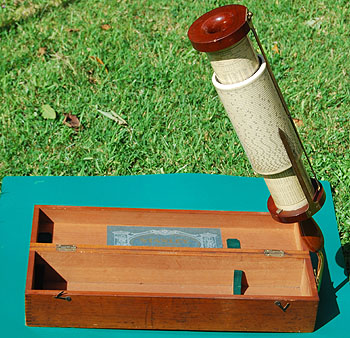
Stanley Fuller Calculator no. 6454 32 made in 1932. Unlike the one above this has a wooden handle and ends and is in excellent condition complete with stand, which it is seen mounted on in the second picture.


The Supreme slide rule. A closed frame, ten inch, mahogany and celluloid rule with plastic cursor, and tables on the reverse. Scales are: M,S,A{B,CR,C}D,T,N. (CR is usually shown as C1 or R; for M & N see above). Another British Slide Rule Co rule dating from the 1940s.


The Technical Aeronautical 10” closed frame mahogany/plastic slide rule dating from 1947 made by the British Slide Rule Co. It has a black card case. Scales are: in\M,P,A{B,P’,CR,C}D,K,N\cm//{S,ST,T}. The tables are for material properties,


The Technical Surveyor’s 10” closed frame mahogany/plastic slide rule dating from the 1940s made by the British Slide Rule Co. It has a grey card case. Scales are: M,A{B,CR,C}D,N//{S,cos,ST,cot,T}. There are map scales on the edges. The reverse has trig formulae and a table of sun’s parallax in altitude.

Otis King model L cylindrical slide rule no. J0479 dating from ca. 1940. This one is nickel plated rather than chrome and has different scales, namely nos. 429 and 430.
This page contains a wide variety of slide rules including ones from the Simplon range of Dargue Bros, a Davis rule probably German made, a Reliance and a Technical. Also there are cylindrical rules - the Otis King made by Carbic, and the Stanley Fuller - and circular ones - the Halden Calculex and the DTC Shetack. Some rules made abroad, but specifically for the British market, are also included


John Davis & Son (Derby) Ltd mahogany & celluloid ten inch closed frame slide rule with steel spring back, British made. It has a brown cloth covered card case. Scales are in\A{B,C}D\cm//{S,L,T}. Probably 1920s. It has the number 23 stamped into the end of the slide.


Davis ‘Glider’ mahogany & celluloid 10” slide rule with spring steel back, British made. The slotted slide was patented in 1925, no 232,037. Scales are: cm\F,A{B,C}D,E\in//{S,T}. It has a leather case. The scales F and E are usually designated K and L.



Davis Autocrat 10” slide rule retailed by A G Thornton. It has a maroon card case. The scales are: in\A{B,C}D\cm//{S,L,T}. It has the number 816 stamped into the end of the slide. Spring steel back. Extended ruler scale in well.
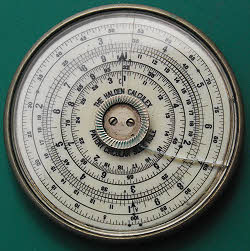
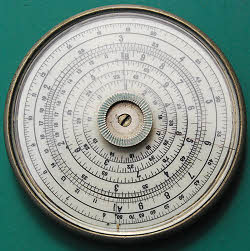
This Halden Calculex differs in construction from the one above. It has a metal case and a red covered instruction booklet.
One glass is cracked and it has lost the ball and ring.

Helix U07 Log Log 10” open frame plastic slide rule marked “Made in England” and possibly made by Blundell Harling. Scales are: L,LL2,LL3,A{B,C1,C}D,S,T,ST. It has a polythene sleeve and instructions. 1960s/1970s
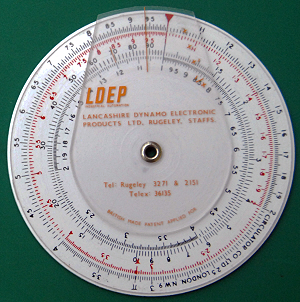



Enhanced Mannheim slide rule stamped H Hughes & Son Ltd in the well, actually made
by John Davis & Sons and dated 1931. Mahogany & celluloid with spring steel back,
scales are in/A{B,C}D/cm//{S,L,T}. It has the usual Davis card case and is basically
an Autocrat but without the extended cm scale in the well.

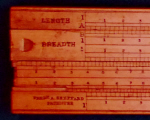
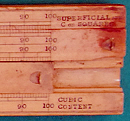
W F Stanley Fredk A Sheppard’s patent Cubing slide rule “with two slides giving at
sight square or cubic contents in feet and inches up to 100 cubic feet, specially
designed for quantity surveyors, timber merchants, etc.”
LOA 25”, scale length 22”. There was also a 12” version.
Left hand end of lower slide broken off.













































































































